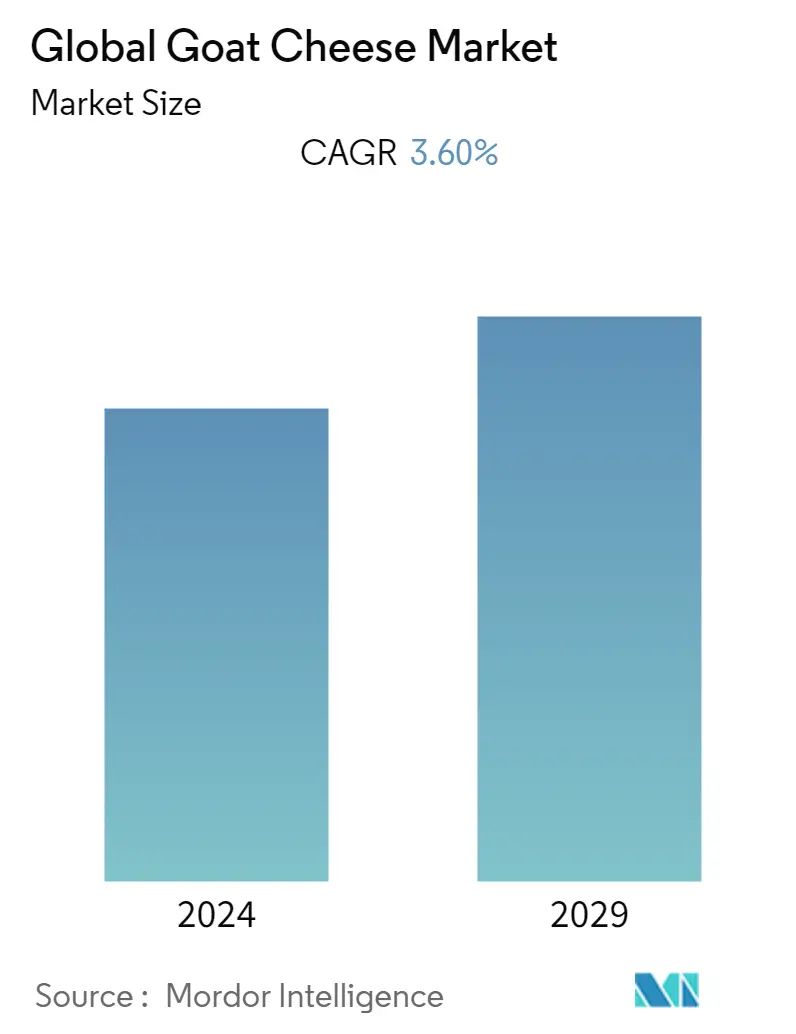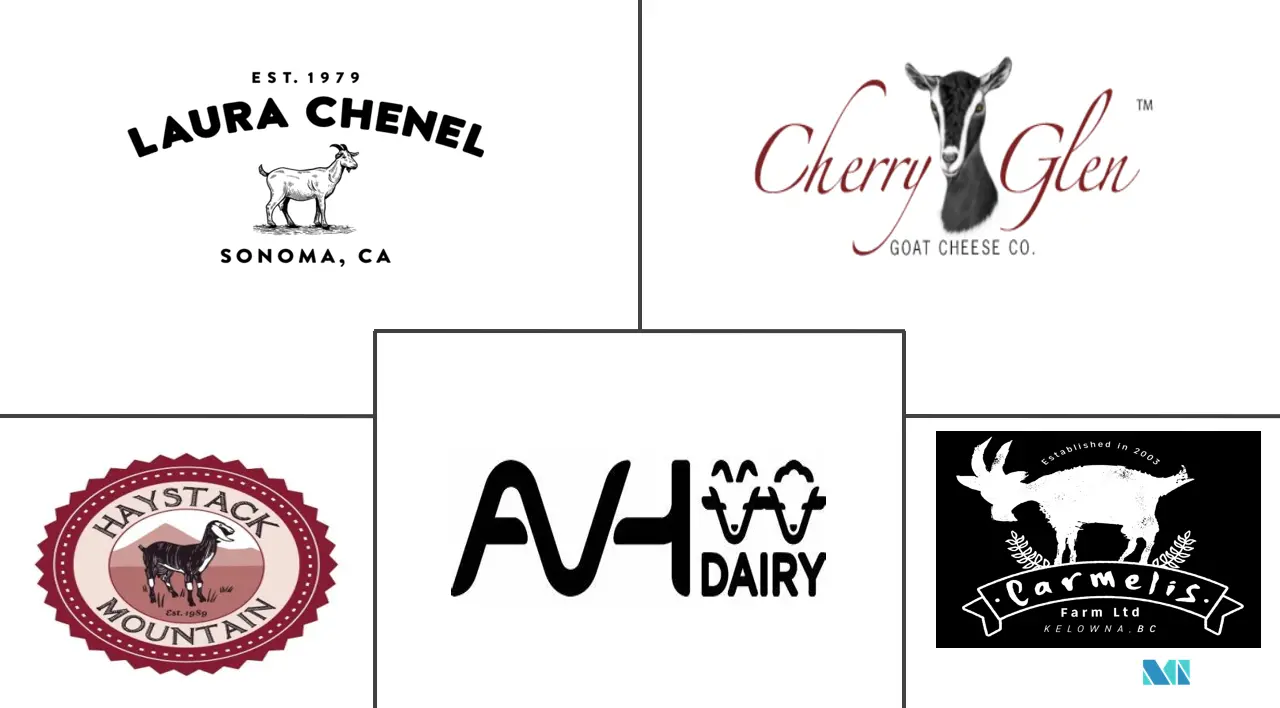Market Size of Global Goat Cheese Industry

| Study Period | 2019 - 2029 |
| Base Year For Estimation | 2023 |
| CAGR | 3.60 % |
| Fastest Growing Market | North America |
| Largest Market | Europe |
| Market Concentration | Medium |
Major Players
*Disclaimer: Major Players sorted in no particular order |
Goat Cheese Market Analysis
The Goat Cheese market is projected to register a CAGR of 3.6% during the forecast period, 2022-2027.
Widespread acceptance of goat cheese in several countries owing to its health benefits is the primary driver of the market. Additionally, goat cheese producers are introducing goat cheese in different flavors in response to consumers' rising interest in fresh, healthful dairy products. For instance, goat cheese is preferred over its conventional counterparts as it contains more protein and less cholesterol than cow cheese. Moreover, the market is being driven by improvements in goat breed quality and technological advancements in cheese production.
Europe is the world's top producer of goat cheese, with France serving as its largest market. Retail sales are anticipated to be driven by the rising demand for goat cheese products in developed economies including the United States, France, and Germany. Africa and Asia are among the regions that eat the most goat milk, although these regions consume less goat cheese than developed markets. However, the rising prevalence of obesity and cholesterol-related disorders in these regions is anticipated to stimulate the preference for goat cheese during the forecast period.
The global goat cheese market has been significantly impacted by the COVID-19 outbreak. The shutdown of major distribution channels all over the world to prevent the coronavirus spread had a substantial impact on the supermarket/hypermarket segment. Manufacturers focused on new tactics to improve the scenario by investing in online distribution and introducing new products. For instance, the U.S.-based cheese company called Consider Bardwell Farm started online retailing by opening a new website in July 2020.
Goat Cheese Industry Segmentation
Goat cheese is a kind of cheese that is made from goat milk. Goat cheese is frequently used in salads or as a spread because of its acidic and salty flavor. The goat cheese market is segmented by type, distribution channels, and geography. Based on type market is segmented into fresh goat cheese, aged goat cheese, flavored goat cheese, and others. Based on the distribution channel market is segmented into supermarkets/hypermarkets, convenience stores, online retail stores, and other distribution channels. Based on geography, the market is divided into North America, Europe, Asia-Pacific, South America, and Middle East and Africa. For each segment, the market sizing and forecasts have been done based on value (in USD million).
| By Type | |
| Fresh Goat Cheese | |
| Aged Goat Cheese | |
| Flavored Goat Cheese | |
| Others |
| By Distribution Channels | |
| Supermarkets/Hypermarkets | |
| Convenience Stores | |
| Online Retail Stores | |
| Other Distribution Channels |
| By Geography | |||||||||
| |||||||||
| |||||||||
| |||||||||
| |||||||||
|
Global Goat Cheese Market Size Summary
The goat cheese market is experiencing steady growth, driven by its increasing acceptance due to health benefits such as higher protein and lower cholesterol content compared to cow cheese. This trend is further supported by advancements in goat breed quality and cheese production technology. The market is characterized by the introduction of various flavors to cater to the growing consumer interest in fresh and healthful dairy products. Europe, particularly France, leads in production, with significant demand also observed in developed economies like the United States and Germany. Although regions like Africa and Asia have a high consumption of goat milk, their goat cheese consumption is lower, but rising health concerns are expected to boost demand in these areas.
The COVID-19 pandemic significantly impacted the goat cheese market, prompting manufacturers to pivot towards online distribution and product innovation to adapt to changing consumer behaviors. North America is poised to maintain a substantial market share, driven by the popularity of low-calorie dairy products and the presence of established goat cheese brands. The region's market growth is supported by technological advancements in manufacturing and a robust supply network. The competitive landscape is marked by major players focusing on product innovation and strategic partnerships to expand into new markets. Notable companies in the sector include Carmelis Goat Cheese, AVH Dairy Trade B.V, and Laura Chenel's Chevre, Inc., among others, who continue to introduce new flavors and products to meet evolving consumer preferences.
Global Goat Cheese Market Size - Table of Contents
-
1. MARKET DYNAMICS
-
1.1 Market Drivers
-
1.2 Market Restraints
-
1.3 Porter's Five Force Analysis
-
1.3.1 Threat of New Entrants
-
1.3.2 Bargaining Power of Buyers/Consumers
-
1.3.3 Bargaining Power of Suppliers
-
1.3.4 Threat of Substitute Products
-
1.3.5 Intensity of Competitive Rivalry
-
-
-
2. MARKET SEGMENTATION
-
2.1 By Type
-
2.1.1 Fresh Goat Cheese
-
2.1.2 Aged Goat Cheese
-
2.1.3 Flavored Goat Cheese
-
2.1.4 Others
-
-
2.2 By Distribution Channels
-
2.2.1 Supermarkets/Hypermarkets
-
2.2.2 Convenience Stores
-
2.2.3 Online Retail Stores
-
2.2.4 Other Distribution Channels
-
-
2.3 By Geography
-
2.3.1 North America
-
2.3.1.1 United States
-
2.3.1.2 Canada
-
2.3.1.3 Mexico
-
2.3.1.4 Rest of North America
-
-
2.3.2 Europe
-
2.3.2.1 United Kingdom
-
2.3.2.2 Germany
-
2.3.2.3 Spain
-
2.3.2.4 France
-
2.3.2.5 Italy
-
2.3.2.6 Russia
-
2.3.2.7 Rest of Europe
-
-
2.3.3 Asia-Pacific
-
2.3.3.1 China
-
2.3.3.2 Japan
-
2.3.3.3 India
-
2.3.3.4 Australia
-
2.3.3.5 Rest of Asia-Pacific
-
-
2.3.4 South America
-
2.3.4.1 Brazil
-
2.3.4.2 Argentina
-
2.3.4.3 Rest of South America
-
-
2.3.5 Middle East & Africa
-
2.3.5.1 Saudi Arabia
-
2.3.5.2 South Africa
-
2.3.5.3 Rest of Middle East & Africa
-
-
-
Global Goat Cheese Market Size FAQs
What is the current Global Goat Cheese Market size?
The Global Goat Cheese Market is projected to register a CAGR of 3.60% during the forecast period (2024-2029)
Who are the key players in Global Goat Cheese Market?
Carmelis Goat Cheese, AVH Dairy Trade B.V, Laura Chenel’s Chevre, Inc., Cherry Glen Goat Cheese Co. and Haystack Mountain Goat Dairy are the major companies operating in the Global Goat Cheese Market.

